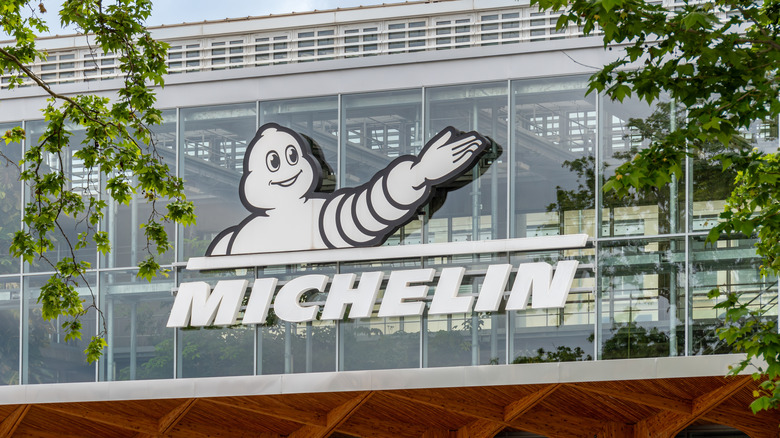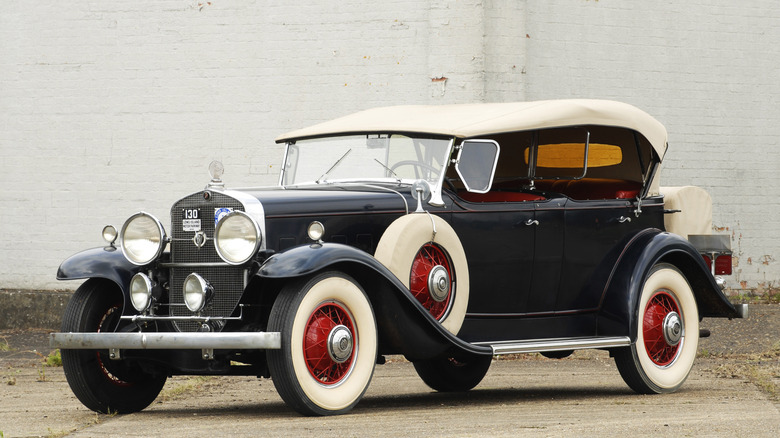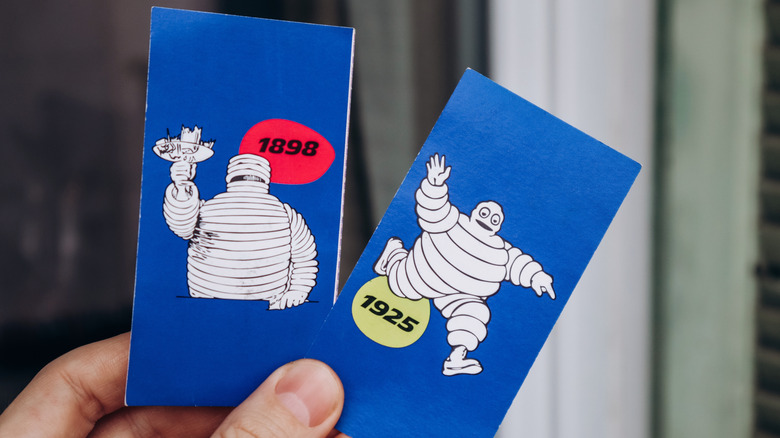Why The Michelin Man Mascot Has White Tires Instead Of Black
There's a lot that is curious about the Michelin brand. Why is a tire company in charge of rating fine dining, for starters? Who even owns it now? And if tires are black, why is the mascot, an anthropomorphic stack of tires, bright white?
His name, by the way, is Bibendum. Friends call him Bib. Today, he's stamped on guidebooks and even lends his name to the "Bib Gourmand" category for affordable restaurants. As the story goes, his look was inspired in 1894, when a pile of tires at the Lyon Universal Exhibition caught French industrialist and company co-founder, Édouard Michelin's eye. "Look, with arms it would make a man," he reportedly said to his brother André. A few years later, they commissioned French artist Marius Rossillon (aka O'Galop) to turn the idea into an ad poster, and Bib was born.
That first version of the mascot raised a goblet brimming with nails and broken glass as a hearty toast, the phrase "Nunc est bibendum" — Latin for "Now is the time to drink" — is printed above the mascots head. Two deflated tires look on in stunned defeat, having failed the same feat. The cheeky slogan declared that Michelin tires could "drink up" road obstacles without harm.
So why white? That has a lot to do with how tires used to look, and how they were made, back in the day.
Tires weren't always black
If you're familiar with vintage vehicles, you might already know that tires used to be white. You've probably seen them in old movies — thinner, and far paler than the ones we use today. That color came from the natural hue of rubber combined with zinc oxide, the go-to recipe for tire-making in the early days of the industry. Naturally, Bibendum followed suit. In fact, the original Bibendum was made up of much thinner tire rings, as the main tire market back then wasn't for cars, but for bicycle wheels, and Michelin started out making those.
It wasn't until 1912 that manufacturers began adding carbon black to tires to make them stronger and more durable. Tires with carbon black could last up to 50,000 miles, yet those without might barely make it past 5,000, according to Goodyear research. The carbon helped diffuse heat and reduce thermal damage, while also making tires easier to clean. At first, it was only added to the tread, leaving the whitewall tires that are now associated with classic cars.
The evolution of Bibendum
Like the Michelin brand itself, Bibendum has evolved over time, but he has retained the white-tire look as a nod to his origins and a testament to the brand's longevity.
Early on, Bibendum caught some flak for his association with drinking — not exactly ideal branding for a brand tied to driving. That early image had been crafted to appeal to the elites of the 19th century, among whom drinking and cigar puffing were common vices, but the company quickly switched gears as public taste shifted. The mascot got a PR-friendly makeover. He quit smoking, abandoned the drink, and gradually took on a more wholesome form. He also swapped the ghoulish grin for something friendlier, and bulked up with thicker tire rings to match the modern look.
After Michelin centralized its creative work, the character's look became consistent. These days, a primary reason the Michelin Man is still white in a world of black tires is because changing him would mean tossing out over a century of brand recognition. Some icons earn the right to stay exactly as they are.


